by Kathryn Lemmon
 The Yuletide connection lured me to the Arctic Circle in December. In northern Finland, pure white snow is measured not in inches but in feet. It’s a place where reindeer herds thrive and Lapland traditional clothing is vibrantly elfish in color and style.
The Yuletide connection lured me to the Arctic Circle in December. In northern Finland, pure white snow is measured not in inches but in feet. It’s a place where reindeer herds thrive and Lapland traditional clothing is vibrantly elfish in color and style.
I found the possibility enticing. Unless you’re a scientist, you can’t get much closer to the North Pole. It wasn’t a tough decision, sign me up!
If you’re looking for an unconventional holiday and once-in-a-lifetime experiences, hop a plane for Helsinki. The Arctic Circle is a convenient one-hour flight north of Helsinki and there’s no need to bring bulky clothing—but more later.
Finland is a small nation of just over 5 million people and about 200,000 reindeer, give or take a Rudolf or two.
You can visit Finland anytime in early December as I did, to experience Yuletide traditions and still be home for the actual holiday. The city of Rovaniemi, Finland, lies at the Arctic Circle. It’s not as far-flung as you might imagine, having the northern-most McDonald’s restaurant in the world.
Prior to my departure I saw a segment on television about Finland. As it turns out, the President is a red-headed woman with a resemblance to TV personality Conan O’Brien. The American talk show host made quite a to-do about the likeness. O’Brien met with her and made all manner of jokes about it on national TV both here and there. Fortunately, the Finns have a sense of humor.
From Helsinki, Finnair will whisk you quickly to Rovaniemi, where the airport runways are lined by stately, snow-heavy pine trees. Stepping off the plane, I got an anticipatory chill, knowing I was so very close to crossing the Arctic Circle.
In Rovaniemi, the arctic is one big playground and snow a source of pleasure. Remote or not, standard tourist hotels and restaurants provide all the amenities we’ve come to expect.
My hotel, the Rantasipi Pohjanhovi, offered free computer access in the lobby. Finland is very progressive when it comes to the computer age. Modern tech made it possible to keep up with events back home.
Still wondering about the proper gear? Lapland Safari’s, a major tour company in Rovaniemi, provides all the warm clothing necessary for an arctic adventure. They realize most travelers either don’t own it or would rather not lug it so far. I was outfitted head to toe, by folks very familiar with combating cold temperatures.
All the gear remains in your hotel room to be used as needed, which is just about anytime you set foot outside the door! I loved my “loaner” wool hat and thick wool socks. The wool hat, when combined with the snowmobile suit hood kept my head toasty warm.
This tour company sits immediately next to the Rantasipi. Most of the activities mentioned here were arranged through Lapland Safari’s.
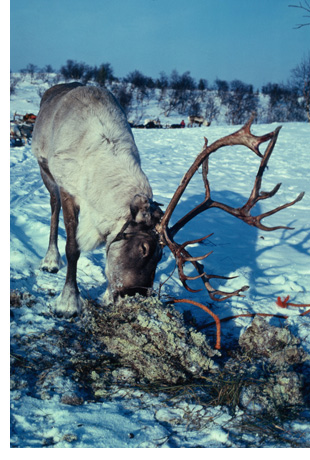 We visited a reindeer farm and rode like the jolly old man himself on a reindeer sled. Bumpy! As the sled had space for two, I was paired with a young man from Spain. He was enthralled with all the white stuff. Though our communication was limited, there was plenty of laughing and smiling. The sled ride did not involve flying over rooftops, I’m sad to report, we stayed attached to terra firma.
We visited a reindeer farm and rode like the jolly old man himself on a reindeer sled. Bumpy! As the sled had space for two, I was paired with a young man from Spain. He was enthralled with all the white stuff. Though our communication was limited, there was plenty of laughing and smiling. The sled ride did not involve flying over rooftops, I’m sad to report, we stayed attached to terra firma.
We had several hours set aside for Santa Claus Village, a white wonderland, constructed partially of snow buildings and ice sculptures. Tall ice obelisks glowed blue and green, illuminating the afternoon darkness. I kept noticing a group of youngsters in the 7 to 12 age range, wearing matching outfits.
They dashed around the village, in an organized fashion so I can only assume they were part of the staff, or perhaps staff off-spring. Their duties appeared to include sledding, playing in the snow, laughing and generally creating a festive feeling. It had the desired effect.
Snowmobiling is an important part of any visit to Rovaniemi. The trails are cut through more pristine, snow-covered pine trees. Acre upon acre of perfectly sculpted snow, without any imperfections is a pleasure to behold. The temperatures cause the snow to cling tenaciously to even the tiniest tree branch.
I took a spill off my snowmobile into the snow, head first. Between loud guffaws, I reminded myself I was sitting in a snow bank in the arctic. Talk about an out-of-this-world sensation! While riding, we could see the moon sitting on the horizon to our left and the sun on the horizon to the right.
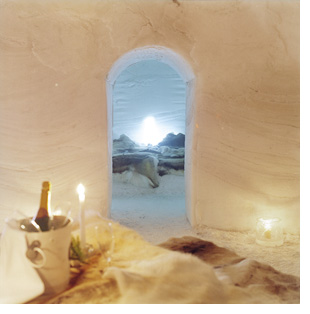 Every winter local residents build an igloo and other buildings collectively called Snowland. Like kids during the first significant snowfall, the men find the urge to build with snow and ice irresistible.
Every winter local residents build an igloo and other buildings collectively called Snowland. Like kids during the first significant snowfall, the men find the urge to build with snow and ice irresistible.
At Snowland I had a warm and tasty dinner in their igloo with steaming hot mushroom soup and a mild white fish as the main course. But even better than the food was the experience itself and the lifelong memories it gave me.
By April, Snowland melts away, to rise again the next December.
The Arctic Center and regional museum of Lapland, called Arktikum is a five-minute taxi ride from the hotel. How have indigenous people survived in this often harsh environment? What exactly is the line on the globe labeled the Arctic Circle? Arktikum explains it all.
While in Arktikum be sure to check out traditional Lapland clothing. It definitely resembles that of Santa’s elves with bold blues and bright red; even shoes with curled up toes.
Although we weren’t able to see the Northern Lights, due to cloud cover, they can be visible in December.
A journey to the arctic around Christmas time is no secret to travelers. I met people from Spain, Singapore, England and some happy honeymooners from Holland.
About the author:
This week Traveling Tales welcomes freelance travel writer Kathryn Lemmon,who lives in Unionville, Indiana. Contact here at her website www.kathrynlemmon.com
Photos by Finnish Tourist Board:
1: Young Lapp boy in traditional costume. Finnish Tourist Board photo.
2: A reindeer munches on lunch. Finnish Tourist Board photo.
3: Inside an igloo in Northern Finland. Finnish Tourist Board.
For more information:
Helsinki: www.gofinland.org.
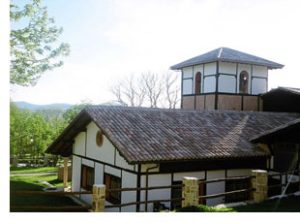
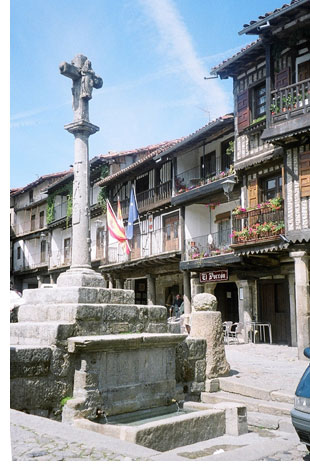 You are responsible for the cost of your flight to Madrid and your accommodations there. A bus will pick you up in Madrid the following morning and four hours later, you will be at a resort near La Alberca, nestled between the mountains in the province of Salamanca, where you will have the experience of your life.
You are responsible for the cost of your flight to Madrid and your accommodations there. A bus will pick you up in Madrid the following morning and four hours later, you will be at a resort near La Alberca, nestled between the mountains in the province of Salamanca, where you will have the experience of your life. A short walk from the resort took us to the enchanted medieval village of La Alberca where we were magically transported back to the 15th century.
A short walk from the resort took us to the enchanted medieval village of La Alberca where we were magically transported back to the 15th century.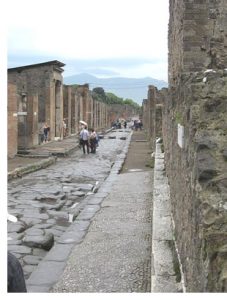
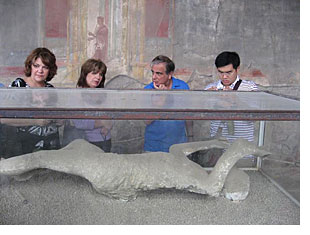 One of the most gruesome, yet fascinating, sights is a collection of plaster casts of people who died during the eruption. Corpses buried under compressed, hardened layers of ash resulted in a hollow space around the skeleton where the flesh had decomposed and melted away. Archaeologists had the brilliant idea of pouring liquid plaster into each of these cavities, thus obtaining realistic casts of Pompeians as they tried to flee from the fiery holocaust.
One of the most gruesome, yet fascinating, sights is a collection of plaster casts of people who died during the eruption. Corpses buried under compressed, hardened layers of ash resulted in a hollow space around the skeleton where the flesh had decomposed and melted away. Archaeologists had the brilliant idea of pouring liquid plaster into each of these cavities, thus obtaining realistic casts of Pompeians as they tried to flee from the fiery holocaust.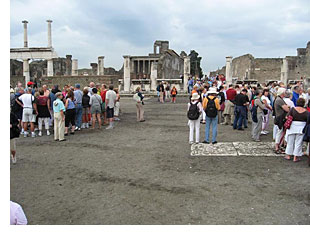 As we drove down to Naples, or Neapolis as Marco called it, I glanced back at the most active volcano on the European continent. Since its last eruptions in 1906 and 1944, it has now been classified as “dormant”.
As we drove down to Naples, or Neapolis as Marco called it, I glanced back at the most active volcano on the European continent. Since its last eruptions in 1906 and 1944, it has now been classified as “dormant”.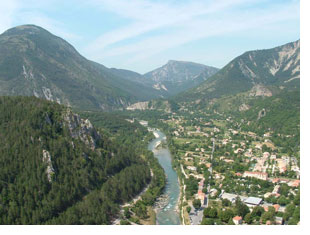 When we finally arrived in Castellane, I pulled the handbrake with a weak, shaky jerk. As I recovered enough to look around, white-knuckled fear left and simple admiration remained. The tiny town guarded the entrance to the Gorges du Verdon, (also known as ‘Grand Canyon du Verdon’) a gorge 21 kilometers long, the Verdon River racing along the bottom.
When we finally arrived in Castellane, I pulled the handbrake with a weak, shaky jerk. As I recovered enough to look around, white-knuckled fear left and simple admiration remained. The tiny town guarded the entrance to the Gorges du Verdon, (also known as ‘Grand Canyon du Verdon’) a gorge 21 kilometers long, the Verdon River racing along the bottom.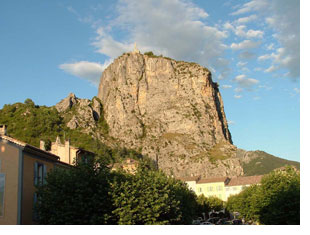
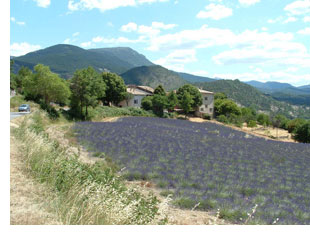 The only disappointment was the lack of lavender fields. Little shops and roadside kiosks sold the requisite lavender seeds, lavender honey, lavender pillows, and pictures of the purple fields, but we had to drive a long way through the Geological Preserve to find just one small, entrancing lavender field bordering a stone house.
The only disappointment was the lack of lavender fields. Little shops and roadside kiosks sold the requisite lavender seeds, lavender honey, lavender pillows, and pictures of the purple fields, but we had to drive a long way through the Geological Preserve to find just one small, entrancing lavender field bordering a stone house.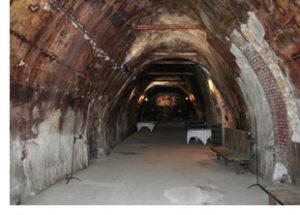
 The tour through the caves was informative and also interesting – an odd mix. The House treated the three of us to a private tour. The walk and three sample glasses of Champagne cost less than a beer at the local pub. Each of us walked away with a general understanding behind the bottling and history of Champagne. Further, it’s a cheap way to taste a few moderately expensive glasses of Champagne.
The tour through the caves was informative and also interesting – an odd mix. The House treated the three of us to a private tour. The walk and three sample glasses of Champagne cost less than a beer at the local pub. Each of us walked away with a general understanding behind the bottling and history of Champagne. Further, it’s a cheap way to taste a few moderately expensive glasses of Champagne. On a Sunday night, the tables began filling up around 8 or 9. After a full course meal and three bottles of wine, we discovered it was past midnight, on a Sunday, and the Square was still packed with locals and a few tourists.
On a Sunday night, the tables began filling up around 8 or 9. After a full course meal and three bottles of wine, we discovered it was past midnight, on a Sunday, and the Square was still packed with locals and a few tourists.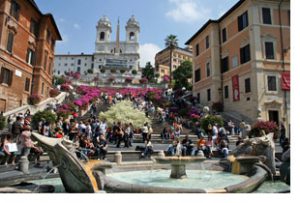
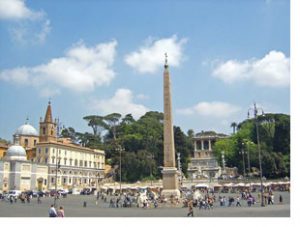
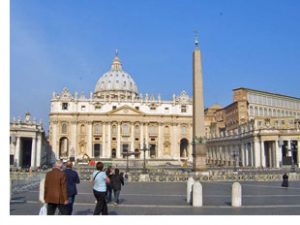
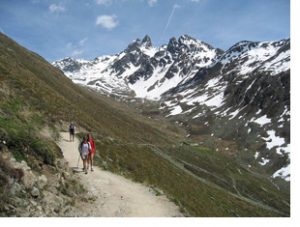
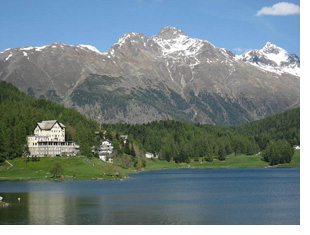 With my trusty guidebook in hand, we walked half way down from the Dorf to the Bad and enjoyed an inexpensive meal in the Co-op Supermarket restaurant. From here, we enjoyed a lovely evening stroll around St. Moritz See. On the return journey, I lost my husband to the imposing Waldhaus am See hotel which claims to have the
With my trusty guidebook in hand, we walked half way down from the Dorf to the Bad and enjoyed an inexpensive meal in the Co-op Supermarket restaurant. From here, we enjoyed a lovely evening stroll around St. Moritz See. On the return journey, I lost my husband to the imposing Waldhaus am See hotel which claims to have the 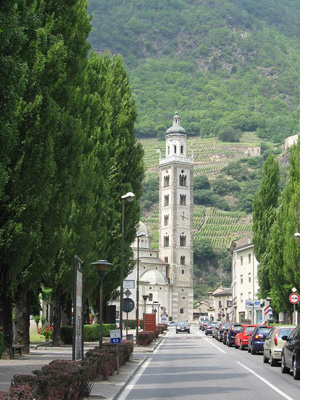 Next on our itinerary was an exciting daytrip aboard the red Bernina Express bound for Tirano in Italy. The route wends its way through corkscrew tunnels and tracks around an amazing circular viaduct.
Next on our itinerary was an exciting daytrip aboard the red Bernina Express bound for Tirano in Italy. The route wends its way through corkscrew tunnels and tracks around an amazing circular viaduct.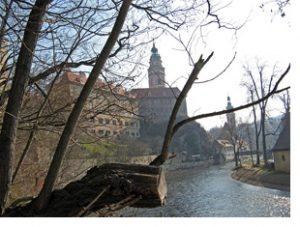
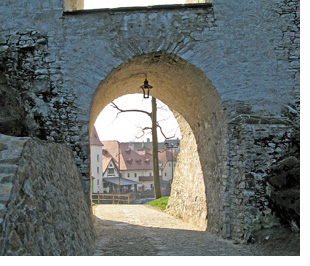 As I started strolling along winding, narrow cobblestone streets that have swallowed up townsfolk and visitors alike for more than 800 years, I continued to marvel at the picturesque sights that greeted me around every corner.
As I started strolling along winding, narrow cobblestone streets that have swallowed up townsfolk and visitors alike for more than 800 years, I continued to marvel at the picturesque sights that greeted me around every corner.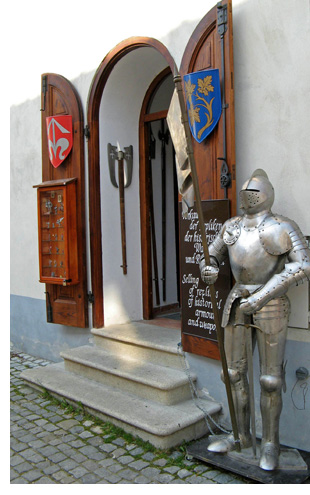 They allowed the innards of many of these heritage buildings to be renovated into hotels with modern-day facilities, charming cafés and pubs, elegant restaurants and quaint little shops that sell everything from suits of armour to wooden toys to profuse offerings of garnet and amber jewellery.
They allowed the innards of many of these heritage buildings to be renovated into hotels with modern-day facilities, charming cafés and pubs, elegant restaurants and quaint little shops that sell everything from suits of armour to wooden toys to profuse offerings of garnet and amber jewellery.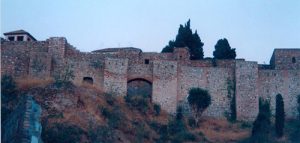
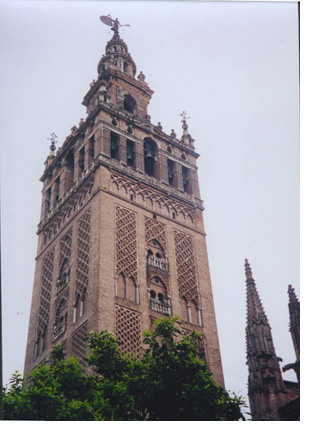 Our daughter quickly spied the signposts pointing to our hotel in Seville’s historic district. After much jockeying, my hubby maneuvered us into an underground space the size of a postage stamp. Abandoning the rental there during our stay, we easily walked everywhere, often along picturesque one-way streets designed long ago for horses and buggies.
Our daughter quickly spied the signposts pointing to our hotel in Seville’s historic district. After much jockeying, my hubby maneuvered us into an underground space the size of a postage stamp. Abandoning the rental there during our stay, we easily walked everywhere, often along picturesque one-way streets designed long ago for horses and buggies.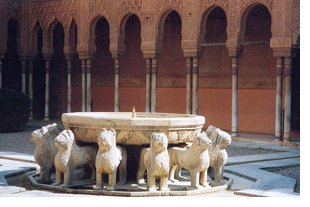 Powerful sultans carried out their domestic lives in luxurious Court of the Lions, harems strictly guarded by trusted eunuchs. Over in the splendid Hall of Kings, entertaining diversions amused sultans and dazzled their guests.
Powerful sultans carried out their domestic lives in luxurious Court of the Lions, harems strictly guarded by trusted eunuchs. Over in the splendid Hall of Kings, entertaining diversions amused sultans and dazzled their guests.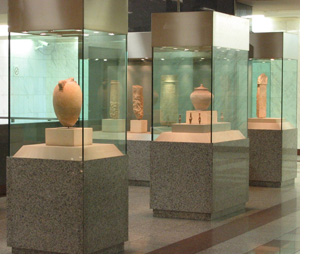
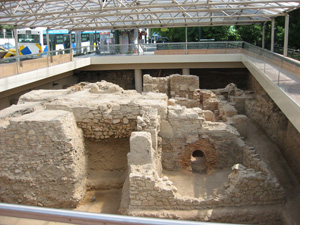 Had the Olympics not come to Athens, it is improbable that a metro would have been built, and the Roman bath would have remained buried. The Olympics brought the city a much improved infrastructure, and unearthed many remnants of the ancient past. Both local Athenians and tourists now have more to see in Athens, and can get around easier – thanks to the Olympics.
Had the Olympics not come to Athens, it is improbable that a metro would have been built, and the Roman bath would have remained buried. The Olympics brought the city a much improved infrastructure, and unearthed many remnants of the ancient past. Both local Athenians and tourists now have more to see in Athens, and can get around easier – thanks to the Olympics.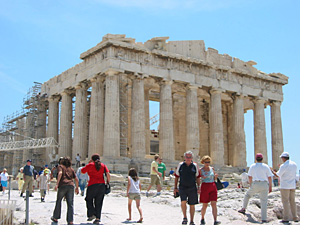 Metro Line 2, or the red line, links most of Athens’ major classical sites including the Temple of Olympic Zeus, the Acropolis, and the Theatre of Dionysos. Also along the red line are the National History Museum, which traces Greek history from the fall of Constantinople to World War II, and the Museum of the City of Athens.
Metro Line 2, or the red line, links most of Athens’ major classical sites including the Temple of Olympic Zeus, the Acropolis, and the Theatre of Dionysos. Also along the red line are the National History Museum, which traces Greek history from the fall of Constantinople to World War II, and the Museum of the City of Athens.